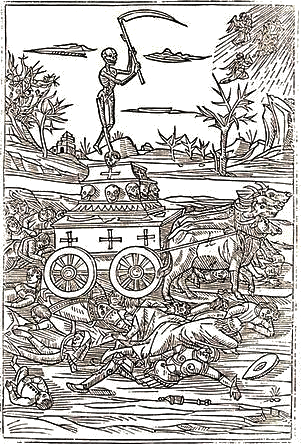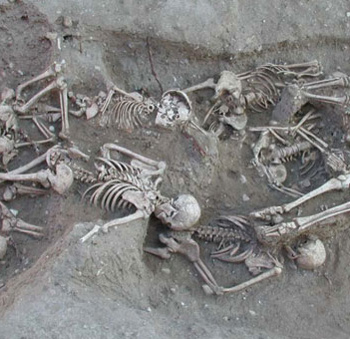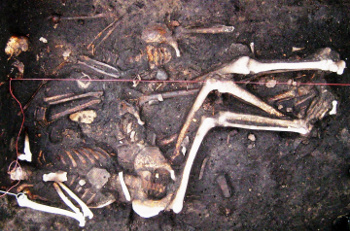Yersinia pestis
February 1, 2016
Every
generation is troubled by it's various maladies, some virulent enough to be denoted as
plagues, but
medical technology keeps trying to stay a step ahead of the darker forces of
nature. In the
20th century,
polio was one such plague. One of my
aunts told me that as a
child she was forbidden to go to
movie theaters for fear of the
virus.
In 1952, during the worst polio outbreak, there were about 58,000 reported cases for which there were 3,145
deaths and more than 20,000 people, mostly
children, left in various states of
paralysis. Noted
physicist,
Philip Morrison (1915 - 2005), was a victim of polio in 1920, at age four, and he needed to wear a
leg brace.
Chemist,
Thomas Midgley, Jr., died from polio, but
not in a way you would expect. A
polio vaccine was developed by
Jonas Salk and introduced in 1955.

Two Pittsburgh people associated with polio. Philip Morrison (left), who contracted polio at age four, lived in Pittsburgh from age two through his college years at Carnegie Tech. Jonas Salk (right) developed the polio vaccine while at the University of Pittsburgh School of Medicine. (NASA photo of Philip Morrison, left, and SAS Scandinavian Airlines photo of Jonas Salk, right, via Wikimedia Commons.)
The
archetypal plague is the
Black Death, which gets its name from the black color of
necrotized tissue of extremities such as
fingers and
toes.
Mortality estimates of this plague, which extended from
Asia through all of
Europe and the
Mediterranean countries over many
decades and peaking in the
mid-14th century, range upwards of 200 million. This was a considerable fraction of the
world population at the time, and the plague cause serious
economic and
social problems.

One of the ways that humans cope with serious things is to make jokes about them. The Black Death was portrayed humorously in the film, Monty Python and the Holy Grail (1975, Terry Gilliam and Terry Jones, Directors),[1] where a medieval entrepreneur charges nine-pence to haul dead, and mostly dead, bodies away.[2] One of the directors of this film, Monty Python's Terry Gilliam, also directed the strange dystopian film, Brazil,[3] a DVD of which is in my collection.
While the Black Death is the best known plague, there was an earlier plague of nearly the same intensity. This was the
Justinianic Plague, or
Plague of Justinian, which is named after the
Byzantine emperor,
Justinian I, who reigned from 527 to 565 AD. Yersinia pestis was the cause of that plague, also, which caused about 25 million deaths in its initial outbreak, and an additional 50 million deaths over two
centuries. Justinian himself was afflicted, but he survived.
The Black Death was conjectured to be a form of the
bubonic plague more than a hundred years ago, but this was only established in the last few years, when
DNA analysis of victims' remains revealed the definite signature of the Yersinia pestis
bacterium. The
DNA was recovered from the
tooth sockets of human
skeletons in mass
graves associated with the plague. The carrier of the
disease is suspected to be the
fleas of
black rats originating in the
Orient and traveling to wild
rodent populations.

Mass grave of bubonic plague victims in Martigues, France. This grave is dated 1720-1721, showing the persistence of the black death beyond its peak, circa 1350.
Most victims of the black death died within a week of initial infection.
(Photo by S. Tzortzis, via Wikimedia Commons.)
A definitive
paper on Y. pestis being the cause of the Black Death was published in 2010 by an international team of twelve
scientists.[4] They took DNA samples from five mass graves associated with the Black Death in
England,
France,
Germany,
Italy, and the
Netherlands, along with three
control sites.[4] The analysis showed that Y. pestis was the cause of the Black Death and that Y. pestis epidemics continued over four centuries.[4] Two variants of Y. pestis were present in later infections.[4]
A recent paper examined DNA recovered from thirty skeletons of the
14th to
17th century, eight of which were plague victims.[5-6] DNA extracted from tooth pulp of one skeleton had Yersinia pestis-specific
nucleic acid concentrations as high as 700 gene copies per
microliter, a severe generalized infection.[5] The skeletons were excavated from
burial sites in Germany that spanned 300 years, one of which a triple
inhumation of three
male soldiers from the time of the
Thirty Years' War, 1618-1648, (see photo).[6]

Triple-inhumation of three male soldiers at Brandenburg, Germany, at the time of the Thirty Years' War (1618-1648)
(Photograph by Seifert et al., Creative Commons Attribution licensed.)
The plague-afflicted skeletons through this lengthy span of centuries had identical Y. pestis
genotype.[6] Thus, Yersinia pestis seems to have persisted from the 14th to 17th century in an unknown
host reservoir.[5-6] This research was funded by the
US Department of Homeland Security Science and Technology Directorate.[5]
References:
- Monty Python and the Holy Grail (1975, Terry Gilliam and Terry Jones, Directors) on the Internet Movie Database.
- Monty Python-Bring out your dead! YouTube Video, August 30, 2007.
- Brazil (1985, Terry Gilliam, Director) on the Internet Movie Database.
- Stephanie Haensch, Raffaella Bianucci, Michel Signoli, Minoarisoa Rajerison, Michael Schultz, Sacha Kacki, Marco Vermunt, Darlene A. Weston, Derek Hurst, Mark Achtman, Elisabeth Carniel, and Barbara Bramanti, "Distinct Clones of Yersinia pestis Caused the Black Death," PLoS Pathog, vol. 6, no. 10 (October 7, 2010), Document No. e1001134, doi:10.1371/journal.ppat.1001134. This is an open access paper with a PDF file available here.
- Lisa Seifert, Ingrid Wiechmann, Michaela Harbeck, Astrid Thomas, Gisela Grupe, Michaela Projahn, Holger C. Scholz, and Julia M. Riehm, "Genotyping Yersinia pestis in Historical Plague: Evidence for Long-Term Persistence of Y. pestis in Europe from the 14th to the 17th Century," PLoS ONE, vol. 11, no. 1 (January 13, 2016), Document No. e0145194, doi:10.1371/journal.pone.0145194. This is an open access paper with a PDF file available here.
- Plague may have persisted in Europe during 300-year period, including 'Black Death,' PLOS Press Release, January 13, 2016.
Permanent Link to this article
Linked Keywords: Generation; pandemic; plague; health technology; medical technology; nature; 20th century; poliomyelitis; polio; aunt; child; movie theater; virus; death; children; paralysis; physicist; Philip Morrison (1915 - 2005); orthotics; leg brace; chemist; Thomas Midgley, Jr.; polio vaccine; Jonas Salk; Pittsburgh; college; Carnegie Mellon University; Carnegie Tech; University of Pittsburgh School of Medicine; Wikimedia Commons; archetype; archetypal; Black Death; necrosis; necrotize; tissue; finger; toe; mortality; approximation; estimate; Asia; Europe; Mediterranean countries; 14th century; world human population; economy; economic; society; social; human; black comedy; humour; humor; film; Monty Python and the Holy Grail; Terry Gilliam; Terry Jones; film director; Middle Ages; medieval; entrepreneur; penny; nine-pence; Monty Python; dystopian fiction; Brazil; DVD; Justinianic Plague; Plague of Justinian; Byzantine Empire; emperor; Justinian I; century; centuries; bubonic plague; genetic testing; DNA analysis; bacteria; bacterium; DNA; tooth; skeleton; grave; disease; flea; black rat; Orient; rodent; grave; Martigues, France; infection; academic publishing; paper; scientist; England; France; Germany; Italy; Netherlands; scientific control; 14th century; 17th century; nucleic acid; microliter; burial; inhumation; male; soldier; Thirty Years' War; Brandenburg, Germany; Creative Commons Attribution license; genotype; natural reservoir; host reservoir; United States Department of Homeland Security; Science and Technology Directorate.